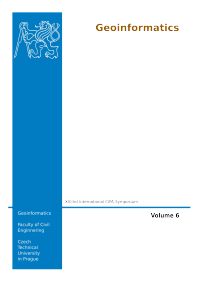From Deposit to Point Cloud – a Study of Low-Cost Computer Vision Approaches for the Straightforward Documentation of Archaeological Excavations
DOI:
https://doi.org/10.14311/gi.6.11Keywords:
excavation, computer vision, low-cost, 3D single-surface recording, orthophotoAbstract
Stratigraphic archaeological excavations demand high-resolution documentation techniques for 3D recording. Today, this is typically accomplished using total stations or terrestrial laser scanners. This paper demonstrates the potential of another technique that is low-cost and easy to execute. It takes advantage of software using Structure from Motion (SfM) algorithms, which are known for their ability to reconstruct camera pose and threedimensional scene geometry (rendered as a sparse point cloud) from a series of overlapping photographs captured by a camera moving around the scene. When complemented by stereo matching algorithms, detailed 3D surface models can be built from such relatively oriented photo collections in a fully automated way. The absolute orientation of the model can be derived by the manual measurement of control points. The approach is extremely flexible and appropriate to deal with a wide variety of imagery, because this computer vision approach can also work with imagery resulting from a randomly moving camera (i.e. uncontrolled conditions) and calibrated optics are not a prerequisite. For a few years, these algorithms are embedded in several free and low-cost software packages. This paper will outline how such a program can be applied to map archaeological excavations in a very fast and uncomplicated way, using imagery shot with a standard compact digital camera (even if the ima ges were not taken for this purpose). Archived data from previous excavations of VIAS-University of Vienna has been chosen and the derived digital surface models and orthophotos have been examined for their usefulness for archaeological applications. The a bsolute georeferencing of the resulting surface models was performed with the manual identification of fourteen control points. In order to express the positional accuracy of the generated 3D surface models, the NSSDA guidelines were applied. Simultaneously acquired terrestrial laser scanning data – which had been processed in our standard workflow – was used to independently check the results. The vertical accuracy of the surface models generated by SfM was found to be within 0.04 m at the 95 % confidence interval, whereas several visual assessments proved a very high horizontal positional accuracy as well.References
Doneus, M., Neubauer, W.:3D laser scanners on archaeological excavations. In: Dequal S.: (Ed.) Proceedings of the XXth International Symposium CIPA, Torino 2005. The International Archives of Photogrammetry, Remote Sensing and Spatial Information Sciences, Vol. 36-5/C34/1, 2005, 226-231.
Doneus, M., Neubauer, W.: Laser Scanners for 3D Documentation of Stratigraphic Excavations. In: Baltsavias, E.P., Baltsavias, M., Gruen, A., Van Gool, L. & Pateraki, M. (eds.). Recording, Modeling and Visualization of Cultural Heritage. Taylor & Francis, 2006, pp. 193-203.
Neubauer, W.: Laser Scanning and Archaeology – Standard Tool for 3D Documentation of Excavations. GIM international – The global magazine for Geomatics 21 (10), 2007, 14–17.
Ullman, S.:The interpretation of structure from motion. Proceedings of the Royal Society of London B 203, 1979, 405-426.
Fisher, R., Dawson-Howe, K., Fitzgibbon, A., Robertson, C., Trucco, E.:Dictionary of Computer Vision and Image Processing. Hoboken, John Wiley & Sons, 2005.
Szeliski, R.:Computer Vision: Algorithms and Applications. London, Springer, 2010.
Hartley, R., Zisserman, A.: Multiple View Geometry in Computer Vision. Cambridge, Cambridge University Press, 2004.
Snavely, N.:Bundler: Structure from Motion for Unordered Image Collections. http://phototour.cs.washington.edu/bundler,2010-10-28.
Microsoft Corporation:Microsoft Photosynth. http://photosynth.net, 2010-10-28.
Verhoeven, G.:Taking Computer Vision Aloft – Archaeological Three-dimensional Reconstructions from Aerial Photographs with PhotoScan. Archaeological Prospection 18(1), 2011, 67-73.
Scharstein, D., Szeliski, R.:A Taxonomy and Evaluation of Dense Two-Frame Stereo Correspondence Algorithms. International Journal of Computer Vision 47, 2002, 7-42.
Seitz, S., Curless, B., Diebel, J., Scharstein, D., Szeliski,R.:A Comparison and Evaluation of Multi-View Stereo Reconstruction Algorithms. CVPR 2006/1, 519–526.
Pollefeys, M., Van Gool, L.:Visual modelling: from images to images. The Journal of Visualization and Computer Animation 13 (4), 2002, 199–209.
Pollefeys, M., Van Gool, L., Vergauwen, M., Cornelis, K., Verbiest, F., Tops, J.:3D recording for archaeological fieldwork. In IEEE Computer Graphics and Applications 23 (3), 2003, 20-27.
Fera, M., Neubauer, W., Doneus, M.:KG Schwarzenbach. Fundberichte aus Österreich 47, 200Ř (200ř), 553-555.
Lowe, D.:Distinctive Image Features from Scale-Invariant Keypoints. International Journal of Computer Vision 60 (2), 2004, 91–110.
Chen, C., Yue, T.:A method of DEM construction and related error analysis. Computers & Geosciences 36(6), 2010, 717-725.
Federal Geographic Data Committee:Geospatial Positioning Accuracy Standards. Part 3: National Standard for Spatial Data Accuracy (FGDC-STD-007.3-199). Reston, 1998.
Böhler, W., BordasVicent, M., Marbs, A.:Investigating Laser Scanner Accuracy, in: Proceedings of the XIXthe CIPA Symposium, Antalya, Turkey. 30 September-4 October, 2003.
Staiger, R.:The Geometrical Quality of Terrestrial Laser Scanner (TLS). In: From Pharaohs to Geomatics. FIG Working Week 2005 and GSDI-8. Cairo, Egypt April 16-21, 2005.
Fera, M., Neubauer, W., Doneus, M., Eder-Hinterleitner, A.:Magnetic prospecting and targeted excavation of the prehistoric settlement Platt-Reitlüsse, Austria. Archaeologia Polona 41, 2003, 165-167.
Downloads
Published
Issue
Section
License
- Authors retain copyright and grant the journal right of first publication with the work simultaneously licensed under a Creative Commons Attribution License that allows others to share the work with an acknowledgement of the work's authorship and initial publication in this journal.
- Authors are able to enter into separate, additional contractual arrangements for the non-exclusive distribution of the journal's published version of the work (e.g., post it to an institutional repository or publish it in a book), with an acknowledgement of its initial publication in this journal.
- Authors are permitted and encouraged to post their work online (e.g., in institutional repositories or on their website) prior to and during the submission process, as it can lead to productive exchanges, as well as earlier and greater citation of published work (See The Effect of Open Access).

